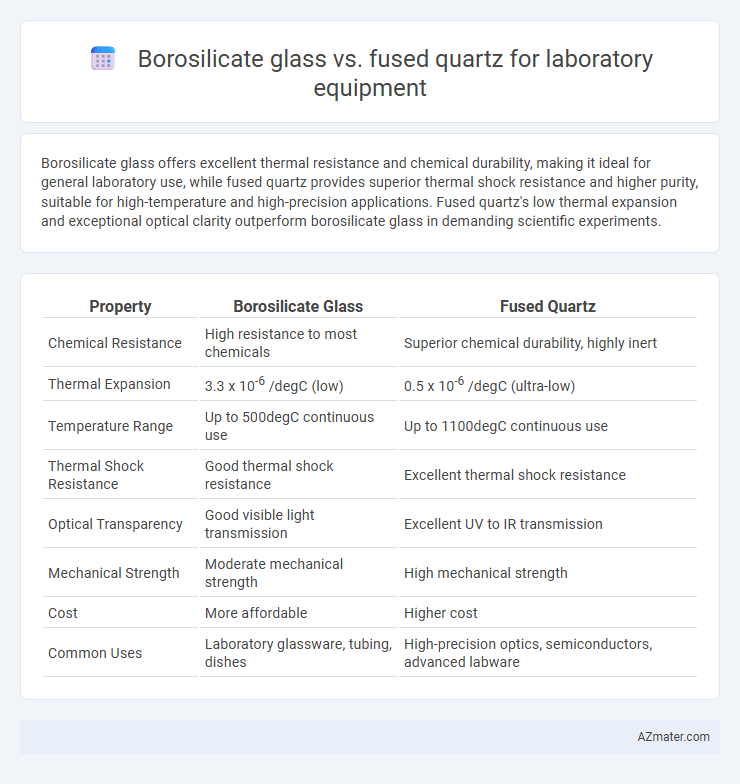Borosilicate glass offers excellent thermal resistance and chemical durability, making it ideal for general laboratory use, while fused quartz provides superior thermal shock resistance and higher purity, suitable for high-temperature and high-precision applications. Fused quartz's low thermal expansion and exceptional optical clarity outperform borosilicate glass in demanding scientific experiments.
Table of Comparison
| Property | Borosilicate Glass | Fused Quartz |
|---|---|---|
| Chemical Resistance | High resistance to most chemicals | Superior chemical durability, highly inert |
| Thermal Expansion | 3.3 x 10-6 /degC (low) | 0.5 x 10-6 /degC (ultra-low) |
| Temperature Range | Up to 500degC continuous use | Up to 1100degC continuous use |
| Thermal Shock Resistance | Good thermal shock resistance | Excellent thermal shock resistance |
| Optical Transparency | Good visible light transmission | Excellent UV to IR transmission |
| Mechanical Strength | Moderate mechanical strength | High mechanical strength |
| Cost | More affordable | Higher cost |
| Common Uses | Laboratory glassware, tubing, dishes | High-precision optics, semiconductors, advanced labware |
Introduction to Laboratory Glass Materials
Borosilicate glass and fused quartz are essential materials for laboratory equipment due to their excellent thermal and chemical resistance. Borosilicate glass, known for its low thermal expansion coefficient (approximately 3.3 x 10^-6 /degC), offers durability and resistance to thermal shock, making it ideal for general-purpose labware such as beakers and flasks. Fused quartz, composed of pure silicon dioxide with an ultra-low thermal expansion coefficient (~0.5 x 10^-6 /degC), provides superior optical clarity and withstands extremely high temperatures, making it suitable for high-precision analytical instruments and high-temperature applications.
Overview of Borosilicate Glass
Borosilicate glass is a type of laboratory glassware made from silica and boron trioxide, known for its excellent thermal resistance and chemical durability. It withstands rapid temperature changes up to approximately 450degC without cracking, making it ideal for heating and cooling applications. Borosilicate glass also exhibits low thermal expansion and high resistance to chemical corrosion, ensuring reliability in various laboratory experiments.
Characteristics of Fused Quartz
Fused quartz exhibits exceptional thermal stability with a melting point around 1650degC, significantly higher than borosilicate glass, making it ideal for high-temperature laboratory applications. Its excellent chemical resistance and low thermal expansion coefficient (approximately 0.5 x 10^-6 /degC) minimize thermal shock and deformation during rapid temperature changes. Optical clarity and ultraviolet transmission properties further enhance fused quartz's suitability for precise scientific experiments and analytical instrumentation.
Thermal Resistance Comparison
Borosilicate glass has excellent thermal resistance with a coefficient of thermal expansion around 3.3 x 10^-6 /degC, allowing it to withstand rapid temperature changes without cracking, making it ideal for most laboratory glassware. Fused quartz surpasses borosilicate in thermal resistance, featuring an extremely low thermal expansion coefficient of approximately 0.5 x 10^-6 /degC, enabling it to endure much higher temperatures and sudden thermal shocks. For applications requiring maximum thermal stability and resistance to thermal shock, fused quartz is the preferred material despite its higher cost compared to borosilicate glass.
Chemical Durability and Compatibility
Borosilicate glass exhibits excellent chemical durability and resists most acids, bases, and organic solvents, making it ideal for general laboratory use. Fused quartz offers superior chemical resistance, especially to hydrofluoric acid and high-purity applications, due to its nearly pure silica composition. Both materials provide strong compatibility with a wide range of reagents, but fused quartz outperforms borosilicate glass in highly corrosive environments.
Mechanical Strength and Durability
Borosilicate glass offers excellent mechanical strength and thermal shock resistance, making it widely preferred for laboratory equipment requiring durability under rapid temperature changes. Fused quartz exhibits superior mechanical strength at high temperatures and exceptional resistance to thermal stress and chemical corrosion, ideal for extreme lab environments. While borosilicate is more affordable and mechanically robust for everyday use, fused quartz delivers unmatched durability and performance in high-precision and high-temperature applications.
Optical Properties and Transparency
Borosilicate glass offers good optical clarity with a visible light transmittance of approximately 90%, making it suitable for general laboratory applications requiring moderate transparency and thermal resistance. Fused quartz provides superior optical properties, including higher transparency across a broader spectrum (UV to infrared) with transmittance exceeding 95%, crucial for precise optical measurements and high-temperature experiments. The low coefficient of thermal expansion and minimal birefringence of fused quartz enhance its performance in high-precision optical instruments compared to borosilicate glass.
Cost Analysis and Availability
Borosilicate glass offers a cost-effective option for laboratory equipment due to its widespread availability and lower manufacturing expenses compared to fused quartz. Fused quartz, although providing superior thermal and chemical resistance, commands a significantly higher price and limited supply, impacting budget-sensitive laboratory setups. Availability of borosilicate glass allows for quicker procurement and replacement, making it preferable in routine laboratory applications where extreme conditions are not mandatory.
Common Applications in Laboratories
Borosilicate glass, known for its thermal shock resistance and chemical durability, is commonly used in laboratory glassware such as beakers, flasks, and test tubes. Fused quartz, with its superior purity and high melting point, is preferred for applications requiring extreme thermal stability and UV transmission, including infrared spectroscopy and semiconductor processing. Both materials serve critical roles in laboratories, with borosilicate favored for general-purpose equipment and fused quartz selected for advanced analytical and high-temperature uses.
Choosing the Right Material for Your Lab
Borosilicate glass offers excellent thermal resistance and chemical durability, making it ideal for general laboratory use where moderate temperature fluctuations and chemical exposure occur. Fused quartz provides superior thermal shock resistance and can withstand extreme temperatures up to 1,100degC, suitable for high-precision applications and specialized equipment requiring maximum purity and minimal thermal expansion. Selecting between borosilicate glass and fused quartz depends on the specific laboratory requirements, including temperature range, chemical compatibility, and the need for optical clarity or mechanical strength.

Infographic: Borosilicate glass vs Fused quartz for Laboratory equipment
 azmater.com
azmater.com